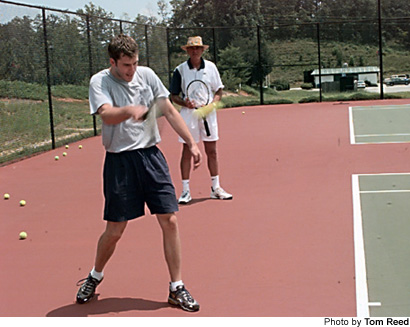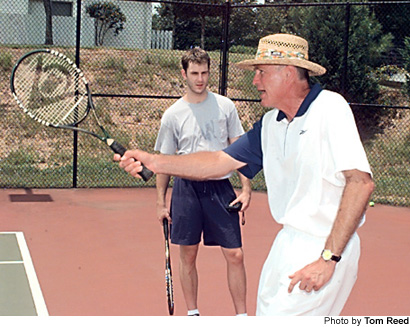
July 27, 1999 — It’s a good thing sports writers put in odd hours.
That way, we can make fools of ourselves on the tennis court while the rest of the world works.
Our follies of would-be volleys go unseen.
Our self-induced tirades unheard.
“And, for that, everyone should be thankful,” said fellow Times staffer Bud Ellis, with whom I make a mockery of the sport on a quasi-regular basis.
To be honest, there are probably worse tennis players out there — somewhere — and since we are relatively equal in our mediocrity, Bud and I actually have some pretty competitive matches.
We do get frustrated, however. Tennis — especially mediocre tennis — will do that to you. And it’s tempting to take it out on the equipment.
To our credit we have yet to break a racket. Even though ours only cost $19.99 at Wal-Mart.
“Dan, $19.99 is not quite up to specs here,” smiled Gary Sherby upon hearing my story. Last week, I decided to remove my ailing tennis game from obscurity and get some help. Sherby, tennis instructor and owner of Racquets & Togs Tennis Center in Gainesville, was happy to oblige.
“We’re going to make a tennis player out of you,” he promised, again smiling.
Bud, watch out.
Sherby handed me a racket — one that likely cost $19.99 many times over — and our lesson began.
Now, one 30-minute tennis lesson does not a champion make. If it did, Sherby likely wouldn’t have much repeat business. If it did, Sherby likely wouldn’t wear a continuous smile.
Thankfully for Sherby, tennis requires repetition. It requires practice. It requires instruction. And Sherby has been providing that to the Gainesville area for the past 13 years.
We both knew I needed much more than one lesson’s worth of work. Several times Sherby mentioned what we would address during my “next visit.”
Lesson No. 1 covered what Sherby says are the two most important aspects of tennis: the serve and the return of serve.
“You get those two shots right you’ll do great,” he said.
Sherby had me serve a couple of times to see what he had to work with.
“That ain’t bad,” he said to my amazement. “I like it.”
Sherby has a laid-back manner to him, the kind you’d expect from a guy who spends his days on the tennis court. He is slender and tanned. He wears shorts and a straw hat to work. And, I suppose not surprisingly, he is always smiling.
It’s not all play, however. Sherby has the same headaches and paperwork that other entrepreneurs do. Profit margins. Inventory. Suppliers. But when Sherby walks outside of his office, he stands on two championship-caliber tennis courts. That’s nice.
“I guess you could call me a tennis pro with a briefcase,” said Sherby, 48, who operates the shop with his wife, Anita — and his 10-year-old daughter, Christina, who was behind the counter during my visit.
The part of my serve that needed the most work, said Sherby, was my toss. A misplaced toss usually results in a mishit serve.
“Balance is an indicator that you’re doing it right,” he explained. If a player falls to the left or right after a serve, that means the toss was too far to the left or right.
Sometimes Sherby has students serve from within a cardboard box. “And if you fall out of that box, you look like a real idiot,” he said. “But it also tells you that your toss was wrong.”
And if you throw a bad toss, don’t hit it.
“I’ve seen champions catch it three, four, five times when it ain’t right,” Sherby said. “A good player is very selective about his tosses.”
So I tossed and I tossed and I eventually got it right.
“Solid as a rock,” Sherby commented. “Man, it sounds great. And that was right in the corner, by the way. Ace.”
“That’s where I was aiming,” I lied.
Placement, I learned, wouldn’t be covered until my “next visit.”
Now it was on to the forehand return, the second half of my lesson.

“Seventy-five percent of the errors in tennis are caused by somebody not concentrating on the ball,” Sherby said.
Sherby has a simple remedy for this problem. When the ball bounces say, “Bounce.” When you hit it say, “Hit.” It forces you to concentrate on the ball.
Balls started shooting from the ball machine. Bounce. Hit. Bounce. Hit. Bounce. Hit. I hit ten perfect shots. It works.
“Bounce-hit cleans up mishits like nothing else I’ve seen,” said Sherby. “If you can just do this when you play tennis, you’ll never miss again. Say it to yourself, though, or people will think you’re crazy.”
We continued, briefly going over the proper grip, racket placement and stroke. Then our time was up.
So much more to learn! It’s hard to stop after just one lesson. Now I know why Sherby is always smiling.
“I want you to come back again and we’ll turn you into a tennis player. Maybe you can beat Christina one of these days,” he said, winking at his daughter.
I don’t know about Christina. But I sure hope Bud has been practicing.
